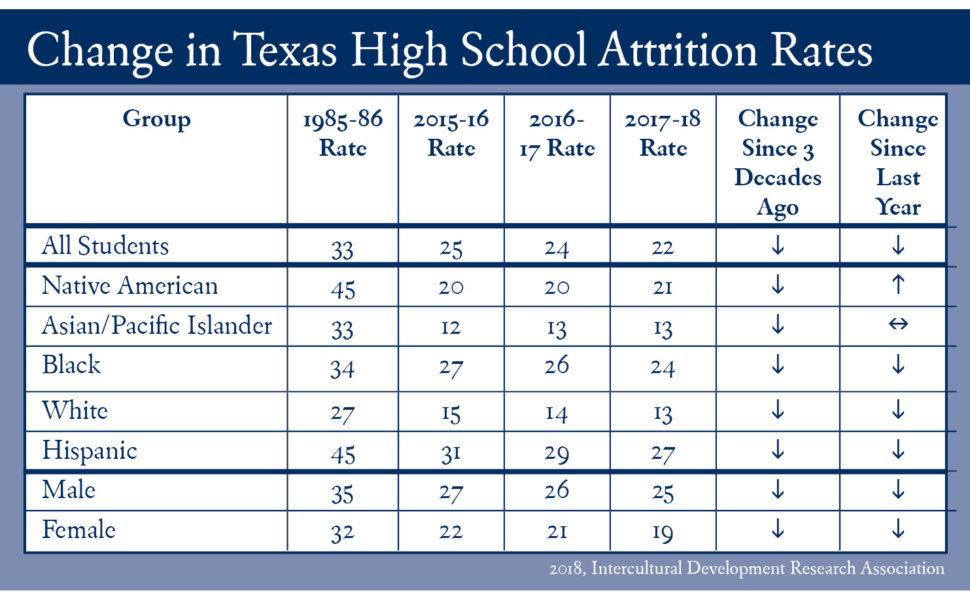• Roy L. Johnson, M.S. • IDRA Newsletter • October 2018 •


The statewide attrition rate of 22 percent is 11 percentage points lower than the initial rate of 33 percent found in IDRA’s landmark 1985-86 study and 2 points lower than last year.
Over the past six years, the overall high school attrition rate in Texas has ranged from 22 percent to 25 percent. It was 25 percent in 2012-13, 24 percent in 2013-14, 24 percent in 2014-15, 25 percent in 2015-16, 24 percent in 2016-17, and 22 percent in 2017-18.
This year’s study is the 33rd in a series of annual reports on trends in dropout and attrition rates in Texas public schools. Since conducting the first comprehensive study of school dropouts in Texas in 1985-86, IDRA has conducted attrition analyses to assess schools’ abilities to hold on to their students until they graduate.
Attrition rates are an indicator of a school’s holding power, or ability to keep students enrolled in school and learning until they graduate. Along with other dropout measures, attrition rates are useful in studying the magnitude of the dropout problem and the success of schools in keeping students in school. In simplest terms, attrition is defined as shrinkage in size or number; therefore, an attrition rate is the percent change in grade level between a base year and an end year.
Today’s attrition rates across racial and ethnic groups are lower than they were over three decades ago when the first attrition study was conducted. Attrition rates of Hispanic students have declined by 40 percent (from 45 percent to 27 percent). Attrition rates of Black students have declined by 29 percent (from 34 percent to 24 percent). Attrition rates of White students have declined by 52 percent (from 27 percent to 13 percent).
Despite the positive trends in attrition rates overall there continues to be concern about the persistent gaps between racial-ethnic groups. Between White students and Hispanic students, the attrition rate gap was 18 percentage points in 1985-86 and 14 percentage points in 2017-18. The gap in attrition rates between White and Black students has increased from 7 percentage points in 1985-86 to 11 percentage points in 2017-18.


Key findings of the latest study include the following.
- Texas public schools are failing to graduate one out of every five students. One out of every five students (22 percent) from the freshman class of 2014-15 left school prior to graduating with a high school diploma.
- A total of 94,767 students from the 2014-15 freshman class were lost from public high school enrollment in 2017-18 compared to 86,276 in 1985-86.
- For the class of 2018, Hispanic students and Black students were two times more likely to leave school without graduating than White students.
- In three decades, the overall attrition rate declined from 33 percent in 1985-86 to 22 percent in 2017-18, a 33 percent improvement.
- The overall attrition rate has been less than 30 percent in the last nine study years.
- Since 1985-86, attrition rates of Hispanic students declined by 40 percent (from 45 percent to 27 percent). Attrition rates of Black students declined by 29 percent (from 34 percent to 24 percent). Attrition rates of White students declined by 52 percent (from 27 percent to 13 percent).
- The attrition gap between White students and Hispanic students was 18 percentage points in 1985-86 compared to 14 percentage points in 2017-18.
- The attrition gap between White students and Black students was 7 percentage points in 1985-86 compared to 11 percentage points in 2017-18. The gap between White students and Black students increased by 57 percent from 1985-86 to 2017-18.
- Since 1986, Texas schools have lost a cumulative total of more than 3.8 million students from public high school enrollment.
- The attrition rates for males have been higher than those of females. In the class of 2017-18, males were 1.3 times more likely to leave school before graduation than females.
- From 1985-86 to 2017-18, attrition rates of male students declined by 29 percent (from 35 percent to 25 percent), while the attrition rates of female students declined by 41 percent (from 32 percent to 19 percent).
IDRA conducts a forecast analysis of the expected year that the attrition rate would equal zero. This supplemental analysis is conducted by IDRA’s Felix Montes, Ph.D., using linear regression models. The analysis predicts that at the current pace Texas will continue to range from 21 percent to 25 percent and will not reach an attrition rate of zero until about the year 2036-37. The IDRA attrition analyses and forecasts show the progress made in school holding power and the challenges that remain in reducing and/or eliminating the persistent gaps among racial and ethnicity groups.
The full study is available on IDRA’s web site at www.idra.org and includes methodology, historical statewide attrition rates and numbers of students lost to attrition categorized by race-ethnicity and by gender, a county-level data map, a county-level attrition rate table, trend data by county, and historical county-level numbers of students lost to attrition.
These and other resources are available at https://www.idra.org/research_articles/attrition-dropout-rates-texas/.
Roy L. Johnson, M.S., is Director of Evaluation. Comments and questions may be directed to him via e-mail at roy.johnson@idra.org.
[©2018, IDRA. This article originally appeared in the October 2018 IDRA Newsletter by the Intercultural Development Research Association. Permission to reproduce this article is granted provided the article is reprinted in its entirety and proper credit is given to IDRA and the author.]


